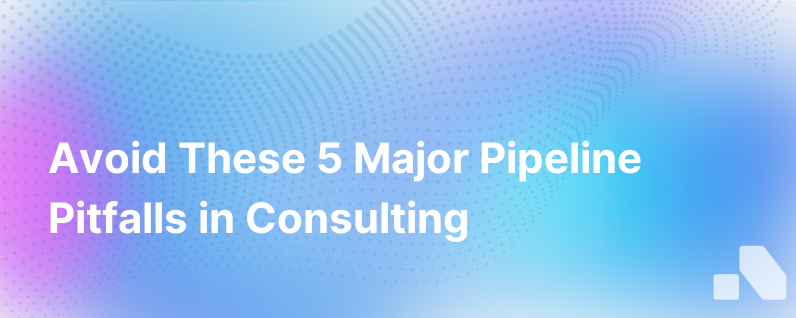
In the world of consulting, where relationships and expertise are currency, effective pipeline management is non-negotiable. It's an intricate dance of identifying leads, nurturing relationships, and closing deals — all while maintaining a delicate balance between your current delivery capacity and future growth opportunities. However, in the quest for expansion, many consulting firms encounter common pipeline pitfalls that can undermine the efficacy of their client acquisition efforts.
Here are the five most prevalent pipeline management mistakes that trip up consulting companies, along with strategies to mitigate their impact:
1. Not Qualifying Prospects Adequately
One typical snare for consulting firms is filling their pipeline with a plethora of leads without rigorous qualification. This often results in spending precious resources on engagements that never actualize or on clients that are a poor fit for the firm’s services.
Solution: Implement a Robust Qualification Framework
Create a qualification checklist that considers factors like budget, decision-making authority, alignment of needs, timing, and cultural fit. Train business development teams to apply this framework during initial interactions to ensure every potential deal aligns with your firm's strategic goals and capabilities.
2. Inconsistent Follow-Ups
Consulting services, by nature, are high-touch and often require significant client education and buy-in. Inconsistent follow-up is a pipeline misstep that can cause consulting firms to lose momentum with prospects, ultimately leading to cold leads or lost opportunities.
Solution: Develop a Structured Follow-Up Process
Implement a structured follow-up strategy leveraging CRM tools to automate reminders and track engagement. Regular, value-adding communication tailored to each prospect’s journey ensures that potential clients feel attended to and that your firm remains top-of-mind.
3. Overreliance on a Few Big Clients
While landing a major client can be a boon for any consultancy, becoming too dependent on a handful of them introduces significant risk into the pipeline. If one big client decides to take their business elsewhere, the firm could face a revenue cliff.
Solution: Diversify the Client Portfolio
Intentionally pursue a mixture of large, medium, and small clients to diversify revenue streams. By cultivating a broad base of clients with varied needs and budgets, consulting firms can mitigate the risk presented by reliance on a few significant clients.
4. Inadequate Visibility Into Pipeline Health
Another common pitfall for consulting firms is not having a clear, real-time view of their sales pipeline. Without visibility, it's challenging to understand which opportunities are advancing, which are at risk, and where to prioritize efforts.
Solution: Leverage Advanced CRM and Analytics Tools
Adopt advanced CRMs and analytics platforms that can provide deep insights into the sales pipeline. Real-time dashboards and reporting can help leaders make data-backed decisions about where to invest time and resources to move opportunities forward.
5. Underestimating the Length of Sales Cycles
Consulting engagements often entail complex solutions to complex problems. As a result, sales cycles can be lengthier than expected, and this underestimation can lead to pipeline misjudgments and inaccurate revenue forecasting.
Solution: Manage Expectations and Plan Accordingly
Track historical sales cycle lengths and create benchmarks according to service lines and client types. Use this data to set realistic timelines and expectations both internally and with clients, which can aid in more accurate forecasting and resource allocation.
Best Practices for Managing Sales Pipeline in the Consulting Industry
To effectively avoid these pitfalls, consulting firms should not only focus on the strategies mentioned above but also on following a set of best practices:
- Regular Pipeline Reviews: Hold consistent pipeline meetings to ensure that opportunities are moving forward and to identify potential bottlenecks early.
- Training and Development: Invest in regular training for your sales team to help them stay current with the latest techniques and tools for pipeline management.
- Value Messaging: Clarify and communicate the unique value your consulting firm brings to clients, adapting this messaging for different stages in the pipeline.
- Collaboration Between Sales and Delivery: Promote close collaboration between your sales and consulting delivery teams to ensure promised solutions are feasible and align with client expectations.
- Client-Centric Culture: Encourage a company-wide culture where understanding and serving clients' needs are of paramount importance. This ethos can shape interactions at every pipeline stage.
Conclusion
Managing a healthy pipeline is fundamentally important for growth and stability in the consulting industry. By learning to identify and sidestep these common traps, consulting firms can ensure that their business development practices yield a steady flow of new engagements without undue risk. It's a complex and ongoing challenge, but with the right strategies, processes, and tools – your consulting firm can not only avoid these pitfalls but turn them into opportunities for innovation and growth.
For those consulting firms looking to further streamline their pipeline management, integrating AI-driven platforms like Aomni can offer an extra edge. Such tools aid in market analysis, prospect qualification, and advanced analytics, ensuring that your pipeline is not just filled, but truly flourishing.